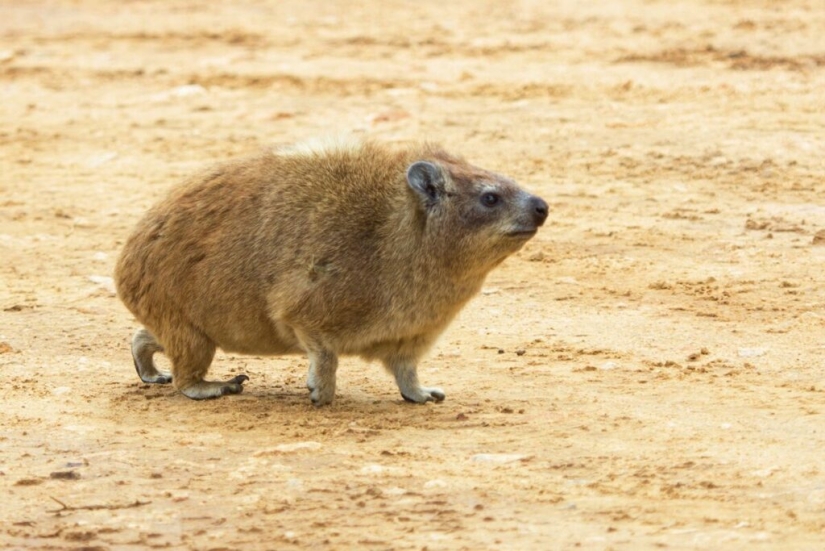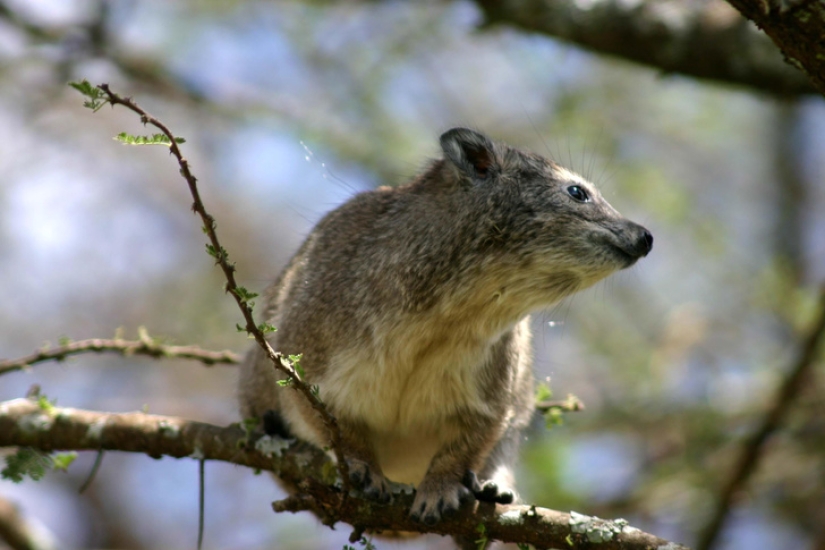Hyraxes are furry relatives of elephants that live in burrows.
Categories: Animals
By Pictolic https://pictolic.com/article/hyraxes-are-furry-relatives-of-elephants-that-live-in-burrows.htmlAppearances can be deceiving, and this is perfectly illustrated by the hyrax. At first glance, it resembles a large, furry rodent and is similar in appearance to a marmot. But despite this, the hyrax has no family ties with this steppe inhabitant. Its closest relatives are elephants and sirens, marine mammals such as manatees and dugongs. The anatomical structure of hyraxes is so unique that scientists have identified them as a separate order - Hyracoidea.

Hyraxes inhabit a vast territory, covering almost the entire Middle East and most of Africa. For locals, these animals are as familiar as hares are to us. The Phoenicians and ancient Jews did not distinguish between hyraxes, hares and rabbits, calling them by one word - "shafan", which translates as "secret", "hiding". This is due to the fact that hyraxes lead a secretive lifestyle and prefer to settle in burrows, rock crevices and other secluded places.

Today, scientists know several species of hyraxes, which have slight differences in size, color, and habitat. Among them are the Cape, mountain, and tree hyraxes. The Cape hyrax prefers to live in the rocky areas of South Africa, the mountain hyrax prefers to live in mountainous regions, and the tree hyrax lives in forests and trees, although they are all very similar in appearance. These differences can only be noticed by specialists, but each hyrax population is unique in its own way.

Hyraxes are animals with a body length of 30 to 60 cm and a weight of 1.5 to 4 kg. Males are almost always larger than females. Their body is baggy, their legs are short, their ears and eyes are small and round. The hyrax's nose is black and very mobile, and its forked upper lip is constantly moving, as if the animal is chewing something. The hyrax has no tail at all, with the exception of tree hyraxes, which have a very short tail.

But the hyrax's outward simplicity is deceptive. Its uniqueness begins with its paws: instead of claws, they have miniature hooves, like those of elephants. Only the middle of the three toes of its hind paws has a claw. This is a rare and amazing feature that emphasizes its kinship with larger mammals.
Another amazing feature of hyraxes is their fur. At first glance, it is unremarkable, the color can vary from cream to black, but most often there are mottled, brown-gray variations. But on the back of the hyrax there is a round spot, where the fur differs in color from the rest of the cover. When the animal is frightened or excited, this fur stands on end, revealing numerous glands with a smelly secretion. This is another feature that makes hyraxes unique among mammals.

Translated from Arabic, "daman" means "ram". Nobody knows why this happened, because these animals look most like marmots. The hyraxes' way of life is also similar. They settle in colonies of 5 to 60 animals in burrows. The animals can dig their own dwellings, but they still prefer to occupy other people's abandoned burrows. In mountainous areas, hyraxes occupy small caves and crevices in rocks.

Despite their awkward appearance, hyraxes are very agile animals. They can climb trees and almost vertical cliffs with lightning speed. Looking at the hyrax's paws with pads and hoof-like nails on the fingers, it is hard to believe. But they have another secret. The paw pads constantly secrete sticky sweat, which improves grip on surfaces. On smooth rocks, the hyrax's paws generally work like suction cups.
The ability to climb rocks and trees is very helpful for hyraxes, which have plenty of enemies. Leopards, mongooses, wolves, jackals and just dogs and cats are not averse to eating these animals. There are also specialized predators that feed only on these animals. The southern black eagle, an African analogue of the golden eagle, hunts exclusively for hyraxes. These eagles hunt in pairs: while one distracts the colony of hyraxes, the other suddenly attacks and grabs the prey.

Interestingly, hyraxes have a kind of "sunglasses". To prevent the bright sun from blinding the hyraxes' eyes, nature has given them a kind of sunglasses - a special growth of the iris that covers the pupil. Thanks to this feature, the animal can see an eagle in the sky even against the blinding sun.

But hyraxes have a major drawback that often costs them their lives. These little animals are incredibly curious. If a person approaches their colony, they will immediately hide in their holes. But if they stand still, the hyraxes will come out to examine the guest. They can look at even potentially dangerous objects for a long time, which eagles often take advantage of. They hunt in pairs, and while one walks around in full view of the colony, the other swoops down and grabs the prey.
The basis of the hyrax diet is young shoots and leaves of plants, as well as roots and bulbs. But on occasion they do not refuse juicy fruits, and in the absence of their usual food they can eat tree bark. When the opportunity arises, they do not miss the chance to feast on insects, for example, during a locust invasion, hyraxes can completely switch to this type of food.

Hyraxes are diurnal animals. They are most active in the morning and evening, when the air temperature is most comfortable. They have poor thermoregulation and on cold nights they huddle together, and during the day they warm themselves in the sun. Despite the fact that the glands on their paws actively consume liquid, they are indifferent to water and are content with the moisture contained in their food.
The reproduction of hyraxes has much in common with their larger relatives, elephants. These animals do not have a strictly defined mating season, but pregnancy lasts a very long time - about 7.5 months. Baby hyraxes are born sighted and covered with fur, and within a few hours of birth they can leave the burrow. At the age of 10 days, they become independent from their mother, and by 16 months they reach full maturity.

As humans increasingly occupy territories, hyraxes are forced to adapt to life near human settlements. In Israel and Syria, they can be found in villages and even cities, where they search for food in garbage cans and dumps. Sometimes they can be seen in attics and utility rooms, but these animals try to avoid direct contact with people. An adult hyrax is almost impossible to tame, but if a baby falls into human hands, it quickly becomes domesticated.

There are many strange creatures in the animal world. The tree shrew is a tropical animal that looks like a squirrel and leads a similar lifestyle, and has nothing in common with rodents.
Recent articles

Sometimes you see a tattoo on a person and think: "Why did he do it at all?". A familiar feeling? If you have never experienced it, ...

Taxi ride like a lottery — you never know if you will pull the winning ticket. Even the official services like Uber does not ...

Finnish photographer Juha Tanhua has shot an unusual series of "space photos". Astrophotographic images of stars, galaxies and ...